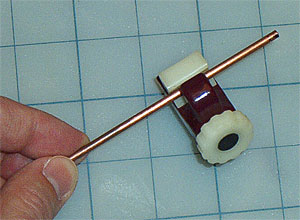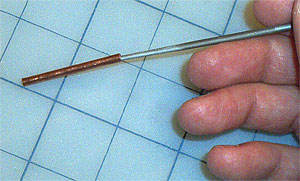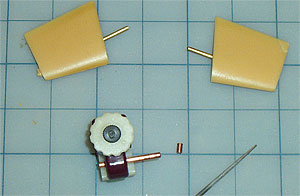|
|
1.
With a 3/32" bit in the chuck, drill the mounting
hole for the upper rudder bearing. It's exact location
is the dimple in the upper stern. |
|
|
2.
Turn the hull over and drill the hole for the lower
rudder bearing. Again, a dimple in the hull indicates
the exact drill point. |
 |
3.
Insert a length of 1/8" o.d. (3/32" i.d.)
brass tubing into the upper rudder bearing hole. Extend
the end of the tubing through the bottom rudder bearing
hole until it is flush with the exterior of the hull.
Then mark the tubing with a sharpie at the upper rudder
hole so the mark is flush with the exterior of the hull. |
|

|
4.
Using a K&S (or other similar) tubing cutter,
cut the tubing on the sharpie mark. |
 |
5.
De-burr the freshly cut end of the tubing with a small
round needle file. The control shaft of the rudder
pieces should be able to slip into each end of the
tube and rotate without binding. |
 |
6.
Slip the tube back into the holes in the hull and insert
the rudders in the top and bottom. |
 |
7.
Make marks on the tube with a sharpie approximately 1/8
inch from the hull on both ends. |
 |
8.
Cut the tube on each mark with the tubing cutter.
The two small pieces will be used as the upper and lower
rudder bearings. Do not discard the center section
of the tube. It will be used in the gluing process.
De-burr all three pieces of tubing with a round needle
file to ensure that the rudder control shafts do not
bind. |
 |
9.
Place the bottom rudder in the hull with the small bearing
on the shaft. Slip the longer, middle tubing piece over
the shaft. With the small upper bearing on the control
shaft, insert the upper rudder into the hull and the
middle connecting tubing. NOTE: the image at left depicts
how the rudders and bearing/tubing pieces will be arranged
in the hull during the gluing process.
The
middle brass tubing piece, though it won't be used in
the final operational rudder setup, serves to keep the
bearings properly located in the hull holes for gluing
and also keeps the upper and lower rudder control shafts
properly aligned. |
 |
10.
Visually check the rudder alignment at this time.
When viewed from astern, the rudders' trailing edge
should form a vertical line through the center of the
hull. If any correction needs to be made, use a round
needle file on the hull holes. NOTE: a little filing
goes a long way on the alignment of these holes. Work
carefully. Once everything checks out, it is time to
glue the bearings in place...
|
| |
Next |



